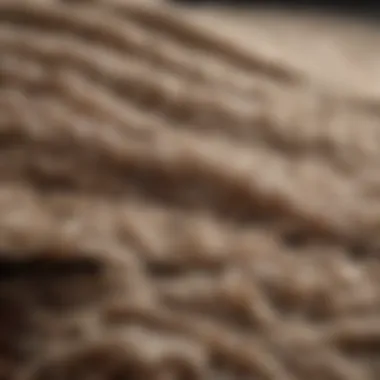The Cleanliness Dilemma: Caring for Wool Rugs


Intro
Wool rugs are more than just functional pieces in a room; they carry aesthetic value and warmth. Yet, potential buyers often hesitate due to common concerns about their cleanliness. Understanding the nature of wool fibers and the maintenance required can alleviate these worries. This article unravels the intricacies of wool rug care, offering insights on cleaning methods and long-term upkeep strategies that can empower buyers to make informed decisions.
Home Features
Key Considerations for Wool Rugs
When selecting a wool rug, consider factors such as the room’s purpose and traffic. Higher traffic areas require more durable options, while low use spaces might benefit from softer varieties. Wool is naturally resistant to dirt and stains. This means that daily maintenance is not as tedious as with other materials. Regular vacuuming can significantly enhance the rug’s longevity and appearance, as it removes debris that can accumulate.
Cleaning Methods
Wool rugs can be cleaned using various techniques. Here are some common methods to keep in mind:
- Dry Cleaning: This method is often preferred, as it uses little moisture, reducing the risk of mold growth. Dry foam products can effectively lift dirt and stains.
- Spot Cleaning: Immediate attention to spills is crucial. Blotting stains with a damp cloth and mild detergent can prevent long-term damage. Avoid rubbing, which can spread the stain.
- Professional Cleaning: For deep cleaning, consider specialists familiar with wool fibers. Their expertise can ensure that the rug retains its quality and structure.
"Wool rugs, while easy to maintain, do require an understanding of their material specifics to ensure lasting beauty."
Maintenance Tips
To maintain the pristine condition of wool rugs, implement the following strategies:
- Rotate Regularly: Changing the position of the rug can prevent uneven wear and fading from the sun.
- Use Rug Pads: These protect the fibers and minimize slipping, adding comfort and security.
- Avoid Moisture: Ensuring that the rug is in a dry area prevents dampness and potential mold.
Closure
In summary, wool rugs represent an investment requiring some maintenance but rewarding it with their unique qualities. Knowing how to care for them can ease concerns and enhance the display of your home. Whether you are an interior design aficionado or merely someone seeking to elevate your space, understanding wool rugs’ cleanliness aspect is crucial.
Prolusion to Wool Rugs
Wool rugs have a distinctive charm and practicality, making them a popular choice for various spaces. The significance of wool rugs lies not only in their aesthetic appeal but also in their functional qualities. Their ability to withstand wear, natural insulation properties, and a broad range of designs offer both comfort and style. Understanding wool rugs is essential for potential buyers. This knowledge assists in making informed decisions about cleaning needs, long-term maintenance, and overall durability. As we analyze wool, we will take a closer look at its unique characteristics and the designs available, laying a foundation for deeper understanding in our following sections.
What Makes Wool Unique
Wool fiber is remarkable for several reasons. First, it is a natural product derived from sheep, which adds an organic aspect to any interior. One of the key features is its ability to trap air within its fibers. This characteristic not only provides warmth but also helps regulate temperatures. Furthermore, wool is inherently resilient. It can undergo significant compression and still retain its shape, making it ideal for high-traffic areas in homes or businesses.
Another unique aspect of wool is its moisture-wicking ability. Wool can absorb moisture without feeling wet, allowing spills to be managed more effectively compared to synthetic fibers. This can be crucial in minimizing staining potential in a home. Additionally, wool possesses natural lanolin, which can help repel dirt.
Popular Styles and Designs


The world of wool rugs is rich with diversity and creativity. From traditional Persian patterns to modern geometric designs, options are abundant.
- Traditional: Persian and Oriental rugs often showcase intricate designs and vibrant colors.
- Contemporary: Minimalistic, flat-weave rugs with bold patterns cater to modern aesthetics.
- Shag: Offering a plush texture, shag rugs provide comfort and warmth, perfect for cozy spaces.
- Outdoor: Some wool rugs are designed for outdoor setting, combining durability and style.
These variety factors in design influence people’s choices, and they reflect individual tastes while considering practical cleaning needs. Understanding the styles available is a crucial element in choosing the right wool rug, which can complement personal or professional spaces effectively.
Understanding Wool as a Fiber
The characteristics of wool make it a subject of interest when discussing the practicality of cleaning wool rugs. Wool is a natural fiber with unique properties that contribute to its reputation as a premier material in flooring. These intrinsic qualities enhance the benefits of wool rugs, making them a consideration for anyone thinking about style, durability, and upkeep.
Natural Durability and Strength
Wool fibers are known for their remarkable durability and inherent strength. One of the most appealing attributes of wool is its ability to withstand wear over time. This resilience stems from the structure of the wool fiber itself, which has overlapping scales and a naturally crimped shape. As a result, wool rugs can handle heavy foot traffic without showing signs of immediate degradation. In addition, this strength makes wool a suitable choice for various spaces, including those frequented by children or pets.
Reliable durability of wool comes with a key advantage: extensive lifespan. When properly cared for, wool rugs can last for decades. This long-term investment aspect is especially important for discerning buyers looking for quality over quantity. Despite their initial costs, the longevity of wool rugs often justifies the expense, especially when compared with synthetic alternatives that may not offer the same durability.
Moisture Resistance
Another significant property of wool is its moisture resistance, which plays an essential role in cleaning and maintenance. Due to the natural lanolin coating found on wool fibers, these rugs excel at repelling moisture. This ability helps prevent spills from penetrating deeply into the fibers, simplifying the cleaning process. Instead of soaking through, water and other liquids often bead up on the surface, allowing for easier blotting and immediate attention.
Moreover, this moisture balance supports the maintenance of indoor air quality. Wool rugs naturally absorb excess humidity from the atmosphere while also releasing it when conditions are drier. This feature allows for a balanced living environment. Such properties mitigate the potential for mold and mildew growth, common issues that can arise with organic materials. Consequently, understanding the moisture-resistant quality of wool becomes a cornerstone when considering the ease of cleaning.
"The easier it is to maintain a rug, the more likely it will remain a favored piece in a home, enhancing the overall aesthetic without excessive work."
Cleaning Challenges with Wool Rugs
Cleaning wool rugs involves specific challenges, which are worth understanding to ensure effective maintenance. Wool fibers, while naturally resilient, can pose cleaning dilemmas. Recognizing these challenges helps owners adopt appropriate strategies and prolong the life of their rugs. Below are three significant cleaning challenges faced with wool rugs:
Absorption of Spills
One of the primary concerns with wool rugs is their ability to absorb spills. Wool has a unique structure that enables it to hold moisture effectively. While this property gives wool its natural resilience, it can also be a drawback. When liquids are spilled on wool rugs, they can penetrate deeply into the fibers.
This absorption can lead to difficulties in cleaning, as standard methods may not suffice. For instance, quick response is essential. The longer a liquid sits, the more challenging it becomes to remove without a trace. Common spills such as red wine or coffee can develop stains if not treated immediately. This| requires not just a quick action but an understanding of which cleaning solutions are best suited for wool. Owners should always dab, never rub, to avoid damaging the fibers.
Dirt and Dust Accumulation
Wool rugs also face the issue of dirt and dust accumulation. While wool's natural oils can repel some dirt, frequent foot traffic can lead to dirt particles embedding in the fibers. This accumulation can diminish the rug’s appearance over time. Moreover, dust mites and allergens can thrive within dirty fibers, affecting air quality and affecting people with sensitivities. Maintaining cleanliness is, thus, critical. Regular vacuuming is essential, yet it is not always enough. Owners should be aware of how to perform vacuuming in an efficient manner to dislodge unwanted particles. Using a vacuum with a gentle brush is recommended.
Potential for Stains
The potential for stains extends beyond typical spills. Certain substances can cause permanent discoloration if left untreated. For instance, pet urine can not only stain but also produce unpleasant odors if it penetrates the fibers. Furthermore, the acidity in some food items can cause dyes in wool to shift, leading to more complex cleaning processes.


It’s important to understand which substances are more likely to cause stains and how to deal with them effectively. Using appropriate cleaning agents tailored for wool can mitigate many issues. Employing a professional cleaning service periodically can also help ensure that deep-rooted stains are properly addressed, contributing to the longevity and cleanliness of the rug.
Understanding these cleaning challenges equips wool rug owners with the knowledge to maximize their investments. Proactive measures can prevent small issues from escalating, resulting in long-term satisfaction with wool rugs.
Effective Cleaning Methods for Wool Rugs
Cleaning wool rugs can be perceived as a challenge. However, with the right techniques, it becomes manageable. This section outlines effective cleaning methods that help maintain the appearance and longevity of wool rugs. Understanding these methods allows for better care and preservation of this luxurious material.
Regular Vacuuming Practices
Regular vacuuming is the cornerstone of wool rug maintenance. It helps remove dirt, dust, and allergens that accumulate on the surface. A vacuum cleaner with a gentle setting is advisable. Strong suction can damage the fibers. It is also recommended to use a vacuum without a beater bar to avoid pulling fibers.
Frequency matters: Aim to vacuum your wool rug at least once a week. For high-traffic areas, more frequent vacuuming might be necessary.
Regular upkeep prevents dirt from grinding into the fibers and helps maintain the rug's original appearance.
Spot Cleaning Techniques
Accidents happen, so understanding how to handle spills and stains is essential. Spot cleaning can mitigate potential damage if done quickly. Begin by blotting the area with a clean cloth to absorb as much liquid as possible. Avoid rubbing, as it can push the stain deeper into the fibers.
Use cold water or a gentle cleaning solution: Mix a small amount of mild detergent with water. Dampen the cloth and work from the outside of the stain inward.
Avoid harsh chemicals: Many household cleaners can harm wool. Always test any solution on a small, inconspicuous area first.
Professional Cleaning Services
While regular maintenance is vital, professional cleaning services are an option for thorough cleaning. These experts can use specialized techniques and equipment that are safe for wool.
Consider the benefits of professional cleaning:
- Deep cleaning removes trapped dirt and allergens
- Preserves the integrity of the fibers
- Often includes treatment for specific stains
It is advisable to consult professionals every 1 to 2 years, depending on the rug's exposure and use. This not only keeps wool rugs looking fresh but also extends their life significantly.
Maintaining Wool Rugs Over Time
Maintaining wool rugs over time is crucial for preserving their beauty and functionality. Wool is a natural material characterized by its resilience and comfort. However, like any textile, it requires attention and care to ensure it remains in optimal condition. The upkeep of these rugs involves a delicate balance between regular maintenance and preventive strategies. Through consistent care, wool rugs can serve as both aesthetic and functional additions to your space.
Routine Care Guidelines
Regular care is essential in maintaining the longevity of wool rugs. Here are some practical guidelines:


- Vacuum regularly: Keeping dirt and debris at bay is vital. A gentle vacuum, used once a week or more, helps to prevent accumulation.
- Rotate your rug: To avoid uneven wear, rotate your rug every few months. This is particularly important in areas with a frequented furniture arrangement.
- Address spills immediately: For any spills that occur, act fast. Blot the spill with a clean cloth without rubbing, as rubbing can push the liquid deeper into the fibers.
- Use a wool-safe cleaner: Occasionally, a deeper clean might be necessary. Select cleaning products that are specifically made for wool to avoid damage.
Preventive Measures for Longevity
Preventive measures can significantly extend the life of wool rugs. Consider the following:
- Place rugs in low-traffic areas: If possible, keep valuable wool rugs in areas with less foot traffic. This helps to minimize wear and tear.
- Use rug pads: Soft pads under rugs provide cushioning and protect flooring beneath, yet also increase safety by preventing slips.
- Avoid excessive sunlight: Direct sunlight can cause fading. Use curtains or blinds to minimize exposure, particularly during peak afternoon hours.
- Regularly treat for moths: Moths can be a concern for wool. Use preventive sprays or natural deterrents to keep pests away.
Storage Considerations
When storing wool rugs, certain considerations can keep them in good shape until they are used again:
- Clean before storage: Ensure the rug is clean and dry before packing. This discourages mold and pests from taking residence.
- Roll, don’t fold: Rolling the rug is better than folding, as it prevents creases and cracks in the fibers. Use acid-free tissue or blankets for added protection.
- Store in a cool, dry place: Avoid hot or damp locations. Ideal storage conditions are cool, dark areas free from humidity.
- Regular checks: Every few months, check on the stored rugs to ensure they aren't developing mold or attracting pests.
"With proper maintenance and care, wool rugs can retain their allure and functionality for generations."
By following these guidelines, individuals can ensure that their wool rugs remain both beautiful and practical for years to come.
Evaluating the Pros and Cons of Wool Rugs
Understanding the pros and cons of wool rugs is crucial for anyone considering their investment in flooring. This evaluation helps buyers weigh the inherent benefits against potential drawbacks. Wool rugs possess unique properties that can influence decision-making, especially in contexts like interior design. It's not just about aesthetics; functionality, maintenance, and comfort all come into play.
Advantages of Wool Fiber
Wool fibers are known for several characteristics that make them desirable in rug manufacturing. Here are some key advantages:
- Natural Resilience: Wool fibers can bend and compress without losing their shape. This resilience contributes to a longer lifespan, making wool rugs a worthwhile investment.
- Quality Insulation: Wool is a natural insulator. It helps regulate room temperature, making spaces feel warmer in winter and cooler in summer, thus enhancing comfort.
- Sound Absorption: The dense structure of wool accompanies sound-dampening qualities. Using wool rugs can reduce noise levels, making for a more tranquil environment.
- Allergy-Friendly: Unlike synthetic fibers, wool has hypoallergenic properties. It does not hold dust mites and some allergens like other materials, making it a preferable choice for sensitive individuals.
- Natural Moisture Absorption: Wool can absorb moisture without feeling damp. This feature aids in controlling humidity levels in a room, benefiting the overall air quality.
“Investing in wool rugs means choosing lasting quality and natural benefits, aligning with both aesthetic and health considerations.”
Disadvantages and Limitations
Though wool rugs come with many benefits, they also have limitations that should be considered. Here are the key disadvantages:
- Cost: Generally, wool rugs are more expensive than synthetic alternatives. The up-front investment can be a deterrent compared to budget-friendly materials.
- Maintenance Requirements: While regular care can prolong their life, wool rugs can be more challenging to clean if stains occur. This complexity may pose a problem for some homeowners.
- Susceptibility to Moths: Wool is a natural product, making it prone to moth infestations. Effective pest control measures are essential to protect wool rugs.
- Fading: Prolonged exposure to sunlight can lead to fading over time. Thus, placement of wool rugs in sunlit areas should be considered in maintenance plans.
In summary, evaluating the pros and cons of wool rugs allows potential buyers to make informed decisions, balancing aesthetics, functionality, and long-term care. For those appreciating quality and enduring craftsmanship, wool rugs provide substantial advantages, despite their limitations.
Culmination
The upkeep of wool rugs is a multifaceted topic that deserves thorough examination. This article provides insight into how wool rugs, despite certain cleaning challenges, can be manageable with the right techniques. Recognizing the unique properties of wool helps illuminate why it requires specific care protocols.
Key elements to understand include the natural durability of wool, its moisture resistance, and the practical cleaning methods available. By applying routine care guidelines and understanding the importance of regular maintenance, one can greatly extend the lifespan of these rugs. Furthermore, considering both the advantages and disadvantages of wool can aid in making an informed purchase decision.
When it comes to maintenance, timely interventions such as spot cleaning can significantly mitigate the effect of potential stains. The importance of preventive measures cannot be overstated; they are essential to maintaining the rug's aesthetic and functional characteristics over time.
In summary, for real estate enthusiasts or design aficionados, understanding wool rug care is both beneficial and practical. It not only enhances the beauty of a living space but also assures one of the long-term durability of their investment in quality home decor. By taking the knowledge from this article into account, readers can navigate the complexities of wool rug maintenance with confidence.















